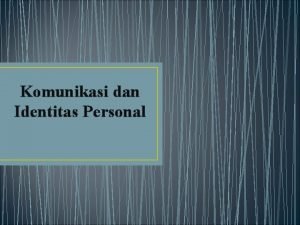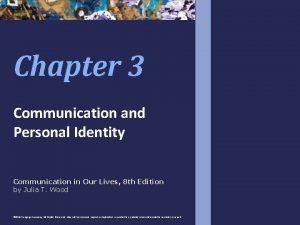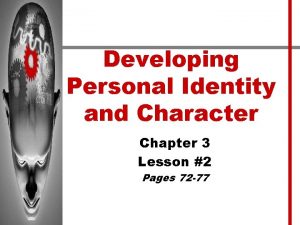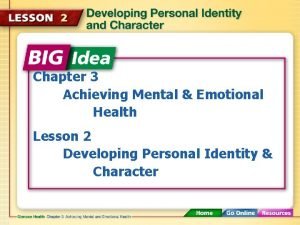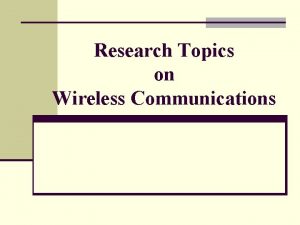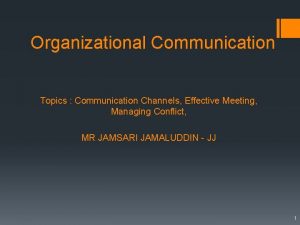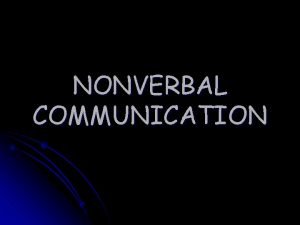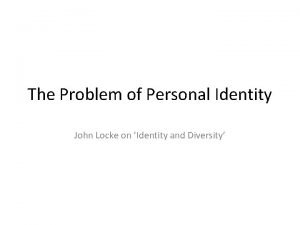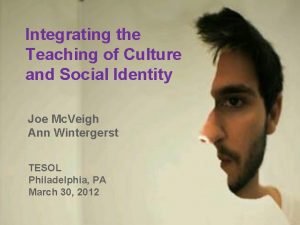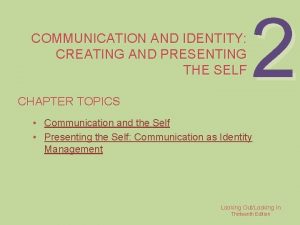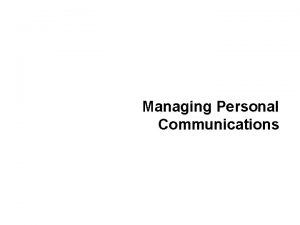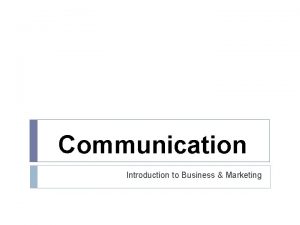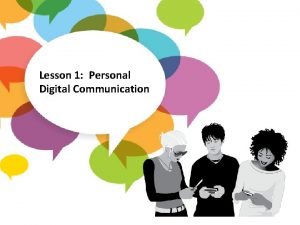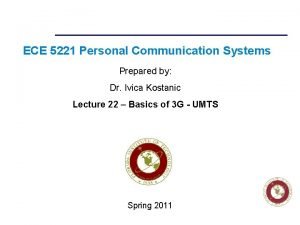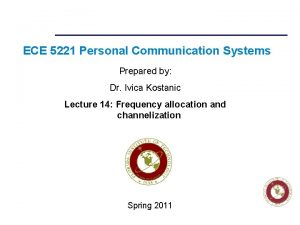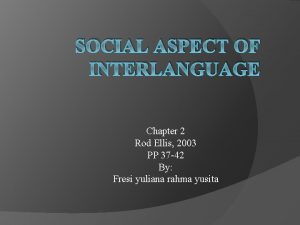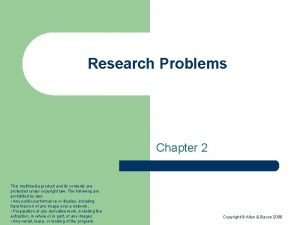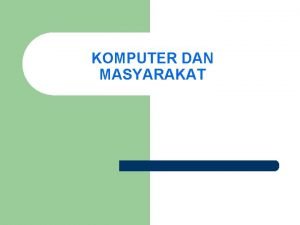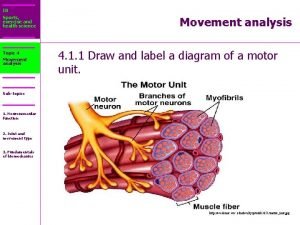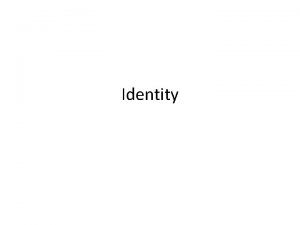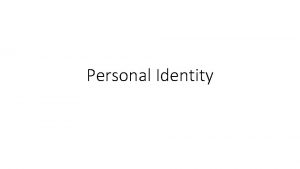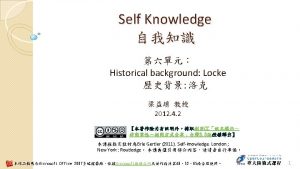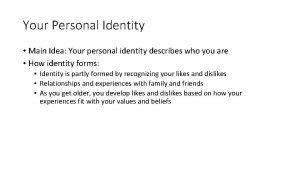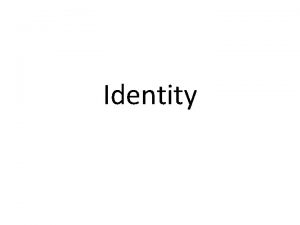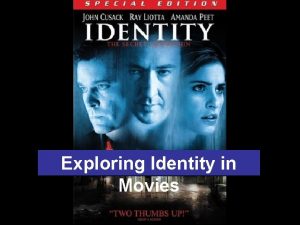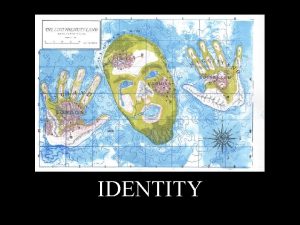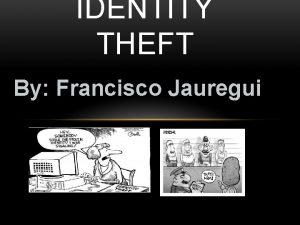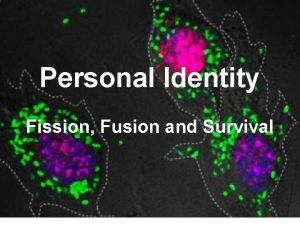Chapter 2 Communication and Personal Identity Topics What









































- Slides: 41

Chapter 2 Communication and Personal Identity

Topics • • What Is the Self? Presenting and Negotiating Identity Social Media and Personal Identity Guidelines for Enriching the Self

After studying • Name forms of communication that shape self-concept. • Recognize examples of face presentation in a particular interaction. • Identify identities that social media idealize

Checking posts • was just selected to be the sports editor for the school paper • friends surprised her with a birthday party • she is having a super vacation in the Bahamas

Checking posts “Why is my life so dull? ” • “I’m not having a great vacation; • my friends don’t surprise me on my birthday; • I wasn’t selected to be editor or anything else. ”

• Most people choose to present themselves positively online. They announce their accomplishments and post about the good, exciting things happening in their lives. • They are less likely to comment on boredom and unhappy aspects of their lives.

questions • Who are you? • How did you develop your identity? • What choices do you make about the identity, or identities, that you present to others, both face to face and online? • How can you improve your self-concept?

Review your own postings and tweets over the past week. How many of them are about you? How many of them exaggerate the positivity of your life?

The Self In some societies, the self does not start at birth • The Arunta people of Central Australia regard a premature infant as a nonperson, an animal that mistakenly has entered the body of the pregnant woman.

• In Ghana, a newborn is a nonperson until it has lived for 7 days. If the child doesn’t live that long, members of the society believe that it was a spirit child, not a human being.

• In Western culture, we believe that a person exists at birth, but what is the self that exists?

The Self • arises in communication and is a multidimensional process of internalizing and acting from social perspectives

The Self Arises in Communication with Others Babies aren’t born with clear understandings of who they are. Instead, we develop a self in the process of communicating with others. Interaction with others usually begins in the family as we learn how our parents, siblings, and other relatives view us. Later, as we interact with peers and teachers, we gain additional perspectives on ourselves.

Still later, when we take jobs, we learn how coworkers, supervisors, customers, and clients see us as employees. We also tune in to media, which give us additional perspectives on ourselves and where we fit in the social world. We internalize many of the perspectives on our identity, and they become part of who we are and how we see ourselves.

Arises in communication with others • by internalizing two kinds of perspectives that are communicated to us: - Perspective of particular others - Perspective of the generalized other

Particular Others • For infants and children, particular others usually include family members and caregivers. Later in life, particular others include peers, teachers, friends, coaches, romantic partners, coworkers, and other individuals who are especially important in our lives. As babies interact with particular others in their world, they learn how others see them. This is the beginning of a self-concept. • Notice that the self starts from outside—with particular others’ views of and communication with us.

• Family members and other individuals who matter to us communicate their views of us through direct definitions, reflected appraisals, scripts, and attachment styles. If parents communicate to children that they are special and cherished, the children are likely to see themselves as worthy of love. • On the other hand, children whose parents communicate that they are not wanted or loved may come to think of themselves as unlovable.

Particular Others § Direct definition § Reflected appraisal – Self-fulfilling prophecies – Social comparison § Identity scripts § Attachment styles

direct definition is communication that tells us explicitly who we are by labeling us and our behaviors. Family members, as well as peers, teachers, and other individuals, define us by telling us who we are or are expected to be. • Positive direct definitions enhance our self-esteem: “You’re smart, ” “You’re strong, ” “You’re great at soccer. ” • Negative direct definitions can damage children’s selfesteem: “You’re troublemaker, ” “You’re stupid, ” “You’re impossible. ” Negative messages can demolish a child’s sense of self-worth. Emotional abuse is just as damaging as other forms of abuse.

reflected appraisal • is our perception of another’s view of us. How we think others appraise us affects how we see ourselves. • Others are mirrors for us—the views of ourselves that we see in them (our mirrors) influence how we perceive ourselves.

One particularly powerful way in which direct definitions and reflected appraisals can affect our self-concept is through selffulfilling prophecies, which occur when we internalize others’ expectations or judgments about us and then behave in ways that are consistent with those expectations and judgments.

• Did your parents ever look disappointed when you acted a certain way? • Did they ever smile with pride when you did something they valued?

Social comparison is the process of assessing ourselves in relation to others to form judgments of our own talents, abilities, qualities • First, we compare ourselves with others to decide whether we are like them or different from them. • Are we the same sex, age, color, religion? • Do we like the same music? • Do we have similar backgrounds? Assessing similarity and difference allows us to decide with whom we fit. Research shows that most people are more comfortable with others who are like them. … • Second, we use social comparison to measure ourselves and our abilities in relation to others. • Am I as good a guard as Hendrick? • Do I play the guitar as well as Chris? • Am I as smart as Serena? • Am I as attractive as Leigh? • Do we have as many friends as others on Facebook? Comparing ourselves to others is normal, and it helps us develope realistic self-concepts.

• Reflected appraisals and direct definitions are not confined to childhood but continue throughout our lives. Teachers who communicate that students are talented in a particular area encourage the students to see themselves that way. Later, as you enter professional life, you will encounter coworkers and bosses who reflect their appraisals of you: You’re on the fast track, average, or not suited to your position. The appraisals of us that others communicate shape our sense of ourselves

self-fulfilling prophecies One particularly powerful way in which direct definitions and reflected appraisals can affect our self-concept is through self -fulfilling prophecies, which occur when we internalize others’ expectations or judgments about us and then behave in ways that are consistent with those expectations and judgments. If you have done poorly in classes where teachers didn’t seem to respect you, and you have done well with teachers who thought you were smart, then you know what a selffulfilling prophecy is. The prophecies we act to fulfill usually are first communicated by others. However, because we internalize others’ perspectives, we may allow their definitions and prophecies for us to become our own.

Many of us believe things about ourselves that are inaccurate. Sometimes, labels that were once true aren’t any longer, but we continue to believe them.

ıdentity scripts • Particular others also influence our identity by providing identity scripts, which are rules for living and identity. • Like the scripts for plays, identity scripts define our roles, how we are to play them, and the basic elements in the plots of our lives.

Think back to your childhood. • Did you hear any of these scripts from family members: “We are responsible people, ” “Our family always helps those in need, ” “A good education is the key to success, ” “Look out for number one, ” or “Live by God’s word”? These are examples of identity scripts people learn in families.

Many psychologists believe that the basic identity scripts for our lives are formed very early, probably by age 5.

attachment styles • Patterns of caregiving that teach us who we and others are and how to approach relationships § § Secure Fearful Dismissive Anxious/ambivalent

The Generalized Other • The views generally held by others in society (Every society and social group has values, experiences, and understandings that are widely shared among members but may not be endorsed by those outside of the culture or group)

§ § § Race Culture Gender Sexual orientation Socioeconomic class

How Are Perspectives of the Generalized Other Revealed to Us? • We learn them as we interact with others, who have internalized cultural values and pass them on to us • We learn them through media and institutions that reflect cultural values • The institutions that organize our society communicate them by the values they uphold

Other Perspectives of Self • The self is multidimensional • The self is a process • Social perspectives are subject to change § Socially constructed views § Variable social views

Guidelines for Improving Self-Concept • Make a firm commitment to personal growth • Gain and use knowledge to support personal growth § You need to understand how your self-concept is formed § You need information about yourself – Self-disclosure

Johari Window: • Open area • Blind area • Hidden area • Unknown area

Guidelines for Improving Self-Concept • Set goals that are realistic and fair (Self. Disclose when Appropriate/Risks of Self-Disclosure) • Seek contexts that support personal change § Avoid self-sabotage

a. List five words that describe how you see yourself. (Examples: responsible, ambitious, introverted, clumsy, funny, intelligent, shy, athletic) b. Next, identify the particular people who have been and are especially significant in your life. Try to think of at least five people who matter to you.

c. Now, think about how these special people communicate with you about the traits you listed in step a. How did they express their appraisals of what you defined as important parts of yourself? Words to Describe You ------------------------ How Others Communicate This to You ------------------------

The blind area contains information that others know about us but we don't know about ourselves Hidden information is what we know about ourselves but choose not to reveal to most others. Open information is known both to us and to others. Your name, height, major, and tastes in music probably are open information that you share easily with others.

The unknown area is made up of information about ourselves that neither we nor others know. According to your text, the author states that it is important to gain access to information in our blind and unknown areas.
 Identity map
Identity map Personal : kelompok =
Personal : kelompok = Communication and personal identity
Communication and personal identity What is good character
What is good character Developing personal identity and character
Developing personal identity and character Lesson 2 developing personal identity and character
Lesson 2 developing personal identity and character Wireless communication research topics
Wireless communication research topics Organizational communication topics
Organizational communication topics Nonverbal communication topics
Nonverbal communication topics Readiness for enhanced spiritual well-being
Readiness for enhanced spiritual well-being Locke personal identity
Locke personal identity Personal sense of identity
Personal sense of identity Identity management in communication
Identity management in communication Chapter 9 topics in analytic geometry
Chapter 9 topics in analytic geometry Gerundio infinitivo participio
Gerundio infinitivo participio Adivinanzas de habitos de higiene
Adivinanzas de habitos de higiene Hakbangin sa buhay kahulugan
Hakbangin sa buhay kahulugan What is oral communication and written communication
What is oral communication and written communication Diff between oral and written communication
Diff between oral and written communication Serial communication and parallel communication
Serial communication and parallel communication Managing personal communications
Managing personal communications Discuss some factor influencing communication
Discuss some factor influencing communication Examples of personal communication
Examples of personal communication Lesson 1 personal digital communication
Lesson 1 personal digital communication Personal communication system
Personal communication system Personal communication system
Personal communication system Direct interactive marketing
Direct interactive marketing Social aspects of interlanguage
Social aspects of interlanguage Stylistic continuum
Stylistic continuum Informative and surprising essay
Informative and surprising essay Examples of research topics and their objectives
Examples of research topics and their objectives Division vs classification
Division vs classification Advanced topics in software analysis and testing
Advanced topics in software analysis and testing Cause and effect essays topics
Cause and effect essays topics Advantage and disadvantage essay
Advantage and disadvantage essay Non researchable problem
Non researchable problem Computer and society topics
Computer and society topics International trade and finance topics
International trade and finance topics Ib sports, exercise and health science topics
Ib sports, exercise and health science topics Ib sports exercise and health science file
Ib sports exercise and health science file Factor isolation question
Factor isolation question Global citizenship education topics and learning objectives
Global citizenship education topics and learning objectives

